Disclosure: Meeple Mountain received a free copy of this product in exchange for an honest, unbiased review. This review is not intended to be an endorsement.
As I noted in our SPIEL preview, the game that was my #1 most anticipated experience was Nucleum, this year’s heavy strategy game from Board&Dice. (Normally, this would be a “T” game co-designed by Daniele Tascini, but that’s not the case for 2023.) I have generally liked every game I’ve gotten from Board&Dice, and the last two—the strangely underrated Origins: First Builders and Tiletum, my 2022 game of the year—have been fantastic.
My source of excitement: Nucleum’s design pedigree. Co-designer David Turczi has been on a tear the last three years, and not just as a solo mode designer. The reviews for Voidfall are strong, the Imperium games (Classics and Legends) are well regarded, and even his lighter designs like the Vengeance: Roll & Fight games have been excellent.
And co-designer Simone Luciani is at a stage in his career where it seems like everything he touches turns to gold. Earlier works like Grand Austria Hotel (the best Euro I’ve ever played), Lorenzo Il Magnifico, and the Marco Polo games are classics, and future classics like Tiletum are never leaving my collection. Even the Luciani games I have liked but not loved (Golem, Darwin’s Journey) were still interesting, even if I am not itching to revisit them.
I was pre-sold on liking Nucleum thanks to the designers. But I had a rough time initially picking up on all the things Nucleum wants to do. The rules are dense in a way I wasn’t expecting. The game isn’t exactly a looker, with a theme and mechanics that have made both friends and fellow content creators compare it to a mix of Brass and Barrage, which I think is a mistake now that I’ve played all three of these games. And the end-game scoring in Nucleum is a bit of a mess.
But much like my appreciation for games like Autobahn, a heavy economical Euro with lots of fiddly processes, Nucleum shines because it is what it says it is—a very challenging, highly strategic race to build a better infrastructure than your opponents. It’s a bumpy ride in its initial plays, but so many things open up during successive plays.
Nucleum is a blast, featuring a number of clever turns in each game. Mix that with variable player powers and a main board that is somewhat different from game to game, and you have a game that will bring back fans of complex strategy games again and again…as long as you take care to clear a few significant hurdles.
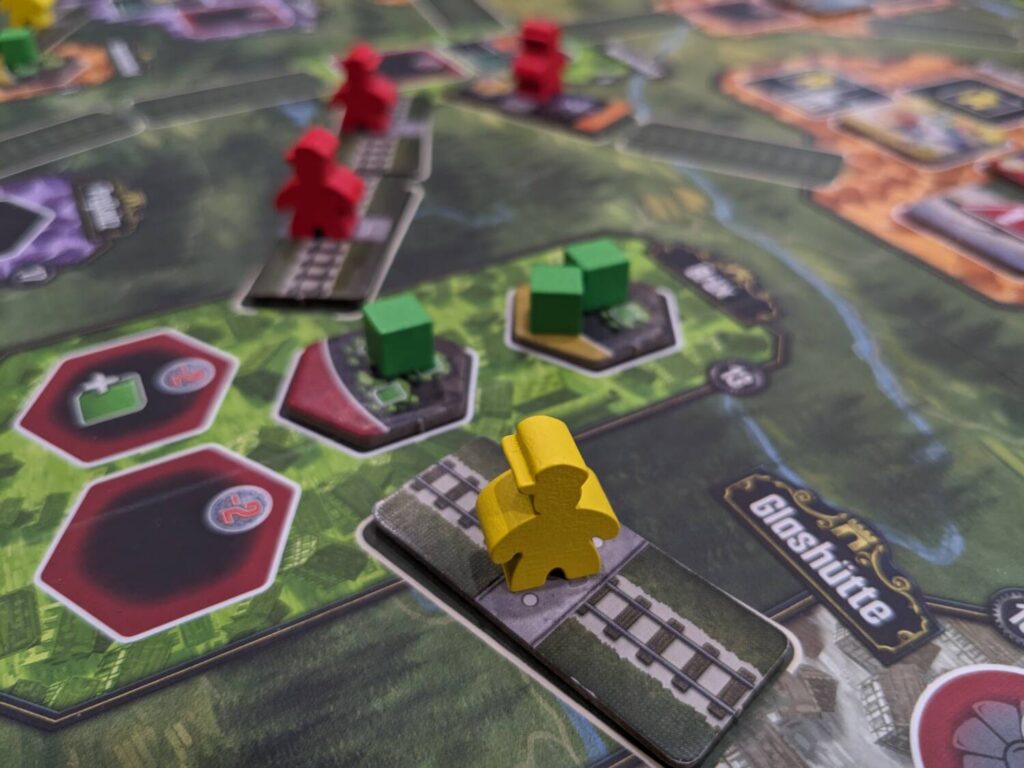
Oh My Goodness, That Teach
“How much of a bear was Nucleum to learn?”
This question arrived in my inbox from a Meeple Mountain colleague, who was curious to learn how my first plays were going. “A big one,” I responded.
There’s no getting around it—Nucleum is a rough onboarding experience. There’s a density to some of the game’s language, made worse if anyone tries to compare Brass to Nucleum because the games are so different. (I get it—both games feature railways, coal and infrastructure. The similarities end there.)
The bigger offender: the game’s iconography. The manual’s appendix and iconography guide are certainly helpful, but there are too many little things to consider each time one looks at an icon. A simple example comes when someone earns a reward.Usually, players get bumps on tracks instead of individual resources, but I swear players made a mistake distinguishing the subtle differences at least 25 times (!!!) during my first three-player game. “Nope, that’s a bump on the worker track, not an individual worker,” I would say, again.
Nucleum’s theme features an alternative history of the 19th century in Saxony: nuclear power, generated from power plants known as “Nucleums”, have brought the future to the present thanks to uranium. The game is not meant to be scientifically accurate, but it does create fun questions about a vision of the past in a steampunk-ish world. Players assume the role of industrialists trying to push their faction to victory, both by powering various buildings on a map of this made-up world and by speeding past competitors to achieve mid-game scoring success, end-game milestones, and network dominance in the form of various building types that can be activated by providing coal and uranium power.
But that’s the broad overview. On a turn, players can use a starting pool of action tiles to do things like move up on tracks on their player board, take one of five main actions (grabbing contracts, building turbines and mines, taking new action tiles, energizing buildings, or erecting buildings on the map), or immediately add workers and/or money to their resource pool. They could, instead, use an action tile to make it a piece of track, permanently burying both a worker and a tile to connect cities and expand their network of building/turbine/mine sites.
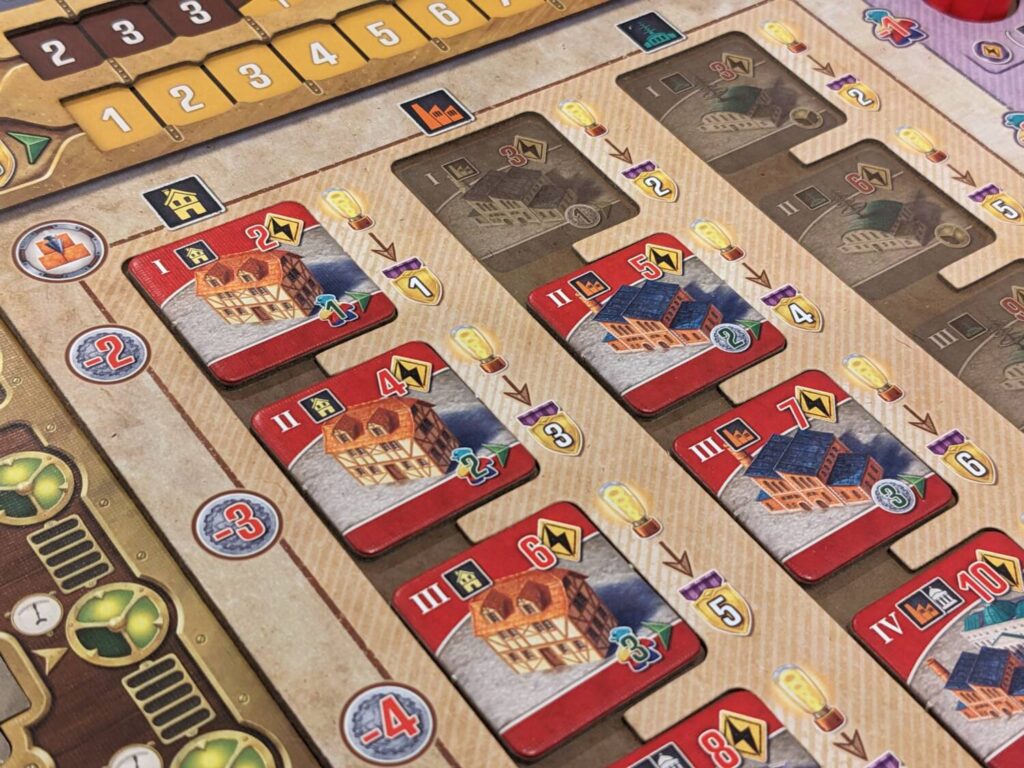
The track actions are really interesting, because players are incentivized to work together to expand the map. To ensure the game is even more complex, each action tile has a color on either end of it. If it matches the location where the track link is built (or matches another player’s track), then players get to take the action on the tile too.
Players don’t have to build on their existing track or from cities where they have buildings, either. In fact, one of the best parts of Nucleum allows players to drop track onto any location anywhere on the map, as long as it extends existing track or is attached to a city. That means that players are virtually never cut off, something that may require players to relearn what it means to play an infrastructure game. (Yes, this means you have a confused player to your left if you told them that Nucleum is “a lot like Brass”…even if you have played Brass just once, you know how confusing it is as a new player to be restricted to only build within “your network.” Don’t teach Nucleum like it is like Brass, people!!!)
If a player doesn’t want to build track or take a normal action, they can instead “recharge”, which generates income for that player in the form of cash, workers, and victory points. Once every player recharges once, a mid-game scoring takes place. These also push achievement trackers onto a six-tier milestone scoring tracker that stacks, which will grant players a ton of end-game scoring points if the players can align the stars just right.
End game conditions are tied to one of five triggers, such as when a player scores 70 in-game victory points, or when the draw pile of contracts runs out. When any two of five conditions are met (three in a solo or two-player game), the current round plays out as normal, then players each get one final turn.
For my first multiplayer game (I played Nucleum solo twice, and twice at three players), I got to watch a guy teach the game to another player…and I only watched the final 35 minutes of the one-hour teach. Nucleum’s icon list is a bit of a nightmare for a new player, even one who is comfortable with heavier stuff (the new player in my first multiplayer game of Nucleum regularly plays Barrage, for example).

What Worked?
Nucleum has a decision space that I really adore. Thanks to a starting contract, four milestone scoring objectives, and three public contracts that serve as milestones, it’s straightforward to tell what types of goals a player should aim for. This is especially true due to how the four major milestones score: based on an achievement system tied to acquiring stars during the game, players can score 1-9x per achievement.
For example, a milestone in the third “segment” of the milestone scoring track could lead to a player scoring four points for that milestone, AND five points for that milestone. Since these stack, that means a player might score a single milestone at nine times its conditional requirements. In one of my games, that milestone was turbines built onto the map, and a player scored 36 points for just that milestone. (For perspective, winners have scored in the 130-160 point range in my plays.)
So, the goals in Nucleum are clear. But getting to those goals, and racing to reach them before others do, has been a blast. Turns are fun, creative, and often quite clever. Sometimes, a contract helps drive behavior on a more tactical level, especially if one sees a way to get what they need now and how to get one of the end-game milestones locked up too. Playing off of others to extend networks is great. Using other players’ rails to move energy to your buildings also feels good.
Each player has a technology board with eight technologies each. Each technology represents one-time actions, ongoing powers, or an end-game scoring goal. When turbines are unlocked, discounts for the energize action persist for that player for the rest of the game. Some of the combos in Nucleum are excellent. We aren’t in Tiletum or Grand Austria Hotel territory here, but these combos are still quite satisfying.
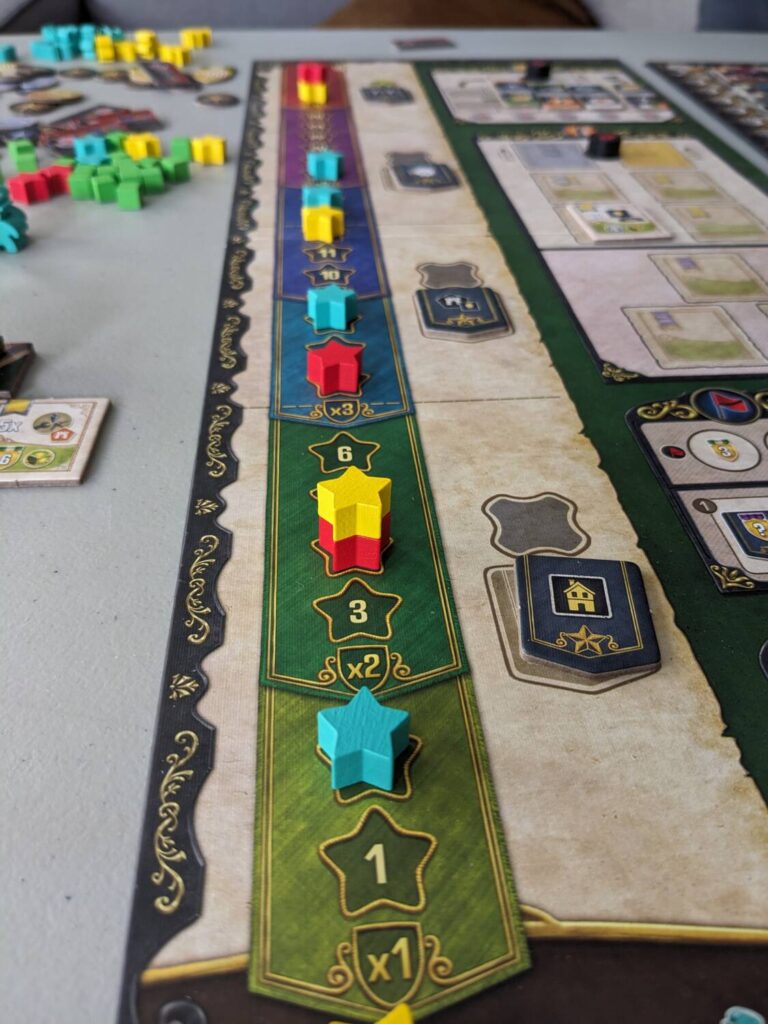
The Best Prep
There are a few conditions that give Nucleum a better chance at success. The first condition is player count. Even during my first read-through of the manual, I knew I would never try Nucleum at four players. I don’t mind that the full player count would lead to more chaos. Rather, the downtime between turns looked (on paper) like it would be massive with four people, especially if one or two of those players suffer from “analysis paralysis” and don’t think through their next turn until it actually is their turn.
That first three-player game of Nucleum took two hours and seven minutes to play, after a one-hour to teach for the new player). My second three-player game took two hours and 12 minutes, with two players who had read the rules beforehand but had never played before. Two hours is perfect for Nucleum, and the ending comes quick!
In that regard, make all your fellow players read the rulebook before your first game. That won’t be enough to fully understand the game, but at least you’ve given everyone a chance to take a first pass at all the examples included in the rulebook. (The manual for Nucleum was proofed by Emmy and Robert Pratt, who do many of the manuals for games Turczi has designed. Their work here is strong, as usual, thanks to all the gameplay examples and the large appendix.)
Third—for your initial plays, pre-assign technology boards. No one knows enough to spend time selecting the perfect one for their playstyle. Then, ask players to study their technology board, particularly the ongoing powers, before the game begins. If players have those things down, mixed with a broad understanding of the rules, that will set up new players for success.

Yep, It’s Good
Nucleum has gotten better with each play, and it’s been fun to try to optimize its puzzle. There’s a lot going on here, but I’m digging it.
The bits that I love most about the game are tied to the tension of timing considerations, particularly around when to build track versus when to take a “regular” turn, in the game’s parlance. A regular turn involves placing an action tile on the top of your player board to take both actions on the tile. A track action might trigger an opportunity to both lay track and extend a network, and take both actions on that action tile, at the cost of the tile and a worker.
Each time I have had the chance to chain these, it felt really good—particularly on a regular turn when you can fulfill a contract either before or after the turn’s main action. That might lead to the unlock of a level one technology where you get a one-time action that provides that tingly feeling of a combolicious action. For every player, that happens a few times a game.
The open network structure means that Nucleum feels less cutthroat than other games of this type. Ultimately, I think that’s a good thing. Players are unlikely to feel like they got shafted during a first play because they were out of the game on turn three. Everyone will complain that they would do a lot differently if they knew better, which is typical for an efficiency game. But that same feeling will be the reason many players will want to try it again.
I played the solo mode twice. Like other Turczi designs, the solo is its own beast—separate rulebook, separate set of cards and a logic engine that drives the behavior of the dummy player. You can also use this automa to have two AI players in a three-player game. I have played a few of Turczi’s other solo designs, and this one is a little less complex than other games, given the overall complexity of the multiplayer version of Nucleum. I was off and running by the halfway point of my first solo game, and the second game was done in about an hour. It’s a fantastic teacher for how one should probably play in multiplayer. I wouldn’t recommend a purchase of Nucleum based only on solo play, however.
Nucleum is not perfect. My major concern is one that is shared with games like Feudum, On Mars, or any “heavy” strategy game. Nucleum will take 45-60 minutes to teach (typical for a Euro that has a 30-page rulebook) and about two hours to play. Nucleum is a terrible “let’s play this game once then never play it again” game. It almost requires an investment of 4-5 plays to really see everything; I’m four plays in, and I’m just now beginning to see the possibilities.
But many players now look at The Hobby™ as an opportunity to play a game once before moving on. I’m not judging here (OK, I am, and I’m shaking my head!), but if that is typical in your group, I think Nucleum should be skipped. Had I only played this game once then moved on, it’s more like a 2.0 out of 5, and not much higher. Nucleum is not interesting as a stumbly one-time play.
Now that I’m a few plays in, a couple other issues have surfaced. The technology boards don’t feel particularly unique. The end-game scoring goal is the main difference between each one (this is the eighth technology on each board); the other powers are interesting but all the boards feel equally viable for each game no matter which one is drafted. The tougher parts of these boards: it’s impossible to keep up with what other players can do, and tracking even a player’s own bonuses is tricky.
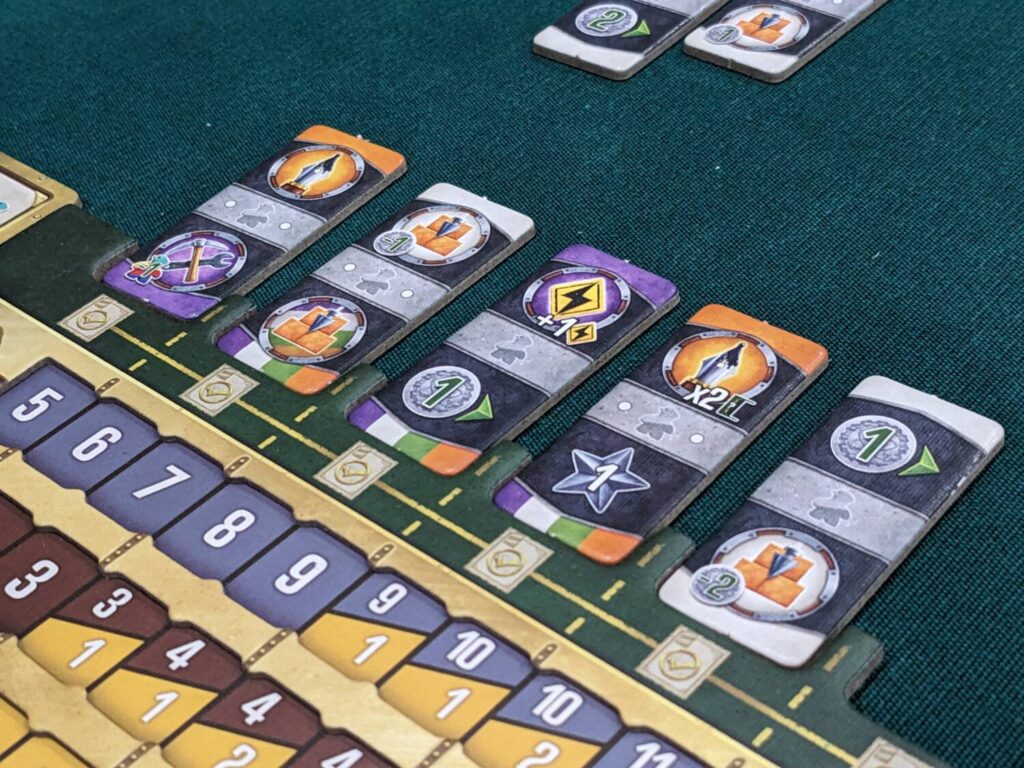
I’m surprised how often I forgot that I could suddenly get a buck every time I energized a building, for example. It’s right there on the board, but players were constantly remembering two or three turns later that they were owed a reward for an ongoing power. But I never remembered when other players were due a reward, or that they had unlocked an ability to build turbines anywhere on the map, not just in their network, for example.
This lends to a minor sense of multiplayer solitaire: you do your thing, and I’m sure it is a legal play. Another offender of these technology boards: there are only four of them. Even in that first multiplayer game, one guy was miffed that there were only four choices of technology boards in the box. That also lends to the feeling that there aren’t that many different things that can be done with that function of the game.
Nucleum has a good rulebook, and a good player aid, detailing the available actions and the breakdown of the technology board for each player. But that aid only details what YOU can do. I need to know what the other players can do. Maybe that feels like too much information…until I realize that the player to my right is gunning to build buildings in as many different cities as possible. Or that they are lining up a turn soon to take two energize actions, which then completes a contract that unlocks a technology that grants another energize action…you get the idea.
My main issue with the player aid is that players really need a third player aid card—one that details all the icons on a double-sided card.
I have a few other minor issues. The cardboard standees that hold Nucleum tokens are weak, as are the technology board cutouts, which have already started to bend with my copy. The setup time is massive (about 25 minutes to do by yourself, from the time you lift the box cover to when you have finished laying out the main board, the boards and pieces for other players, all the resources, and the randomized main map setup). The board is just so bland, in the way that Tiletum’s board was bland. Both boards are incredibly functional but this is not high art.
Nucleum met my expectations for a good time. This is not on the Luciani masterwork tier that includes the games I mentioned at the start of this article. And in a year when Voidfall has come to the world, Turczi’s best work might be that game. I will settle for Nucleum simply being a very solid game from two of the best designers in the business, and I’m glad to have played it a few times. It will stay on my shelf, and hopefully I can find other seasoned Nucleum players to enjoy the experience in the years ahead.


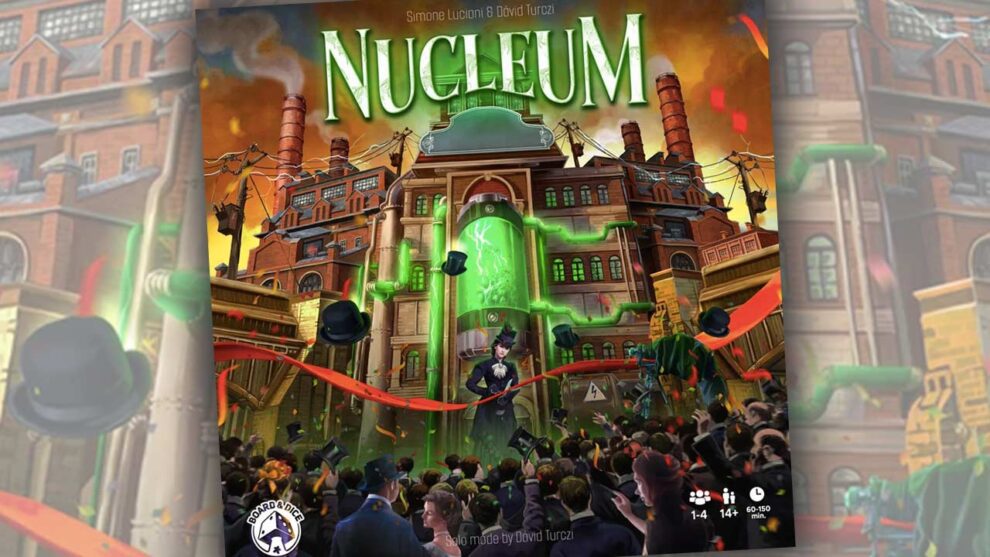









Wow. That was an excellent review and one that has me excited. I have three friends that, I think, would love this. Meaning that this game would get pulled out only when it is the four of us, and that we would be in that four-player setup you are so hesitant to deal with. 🙂 But… I think this is a winner because I know that those guys and I would love a deep, thinky puzzle of a game with a lot of replayability.
If I can work this one into my budget, and I can get those guys interested, and we can all delve into a few four-player plays… I will reach out and let you know how it goes.
Thank you for another great review and read!
Really great review. I’ve played the game now twice (two-handed solo) to get the hang of it and I agree with every point you’ve made. I am going to try teaching it tonight, if there are any takers at the meetup. Wish me luck!
Thanks Mike! I’m excited to try the expansion so I’ll be curious to see what you think about that when it arrives later this spring. Enjoy your first play with other gamers!